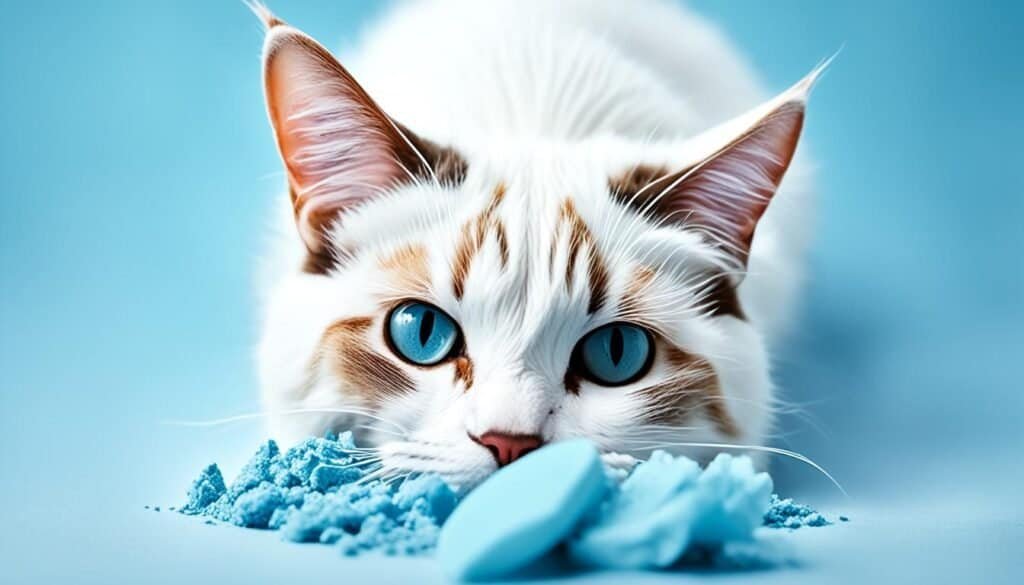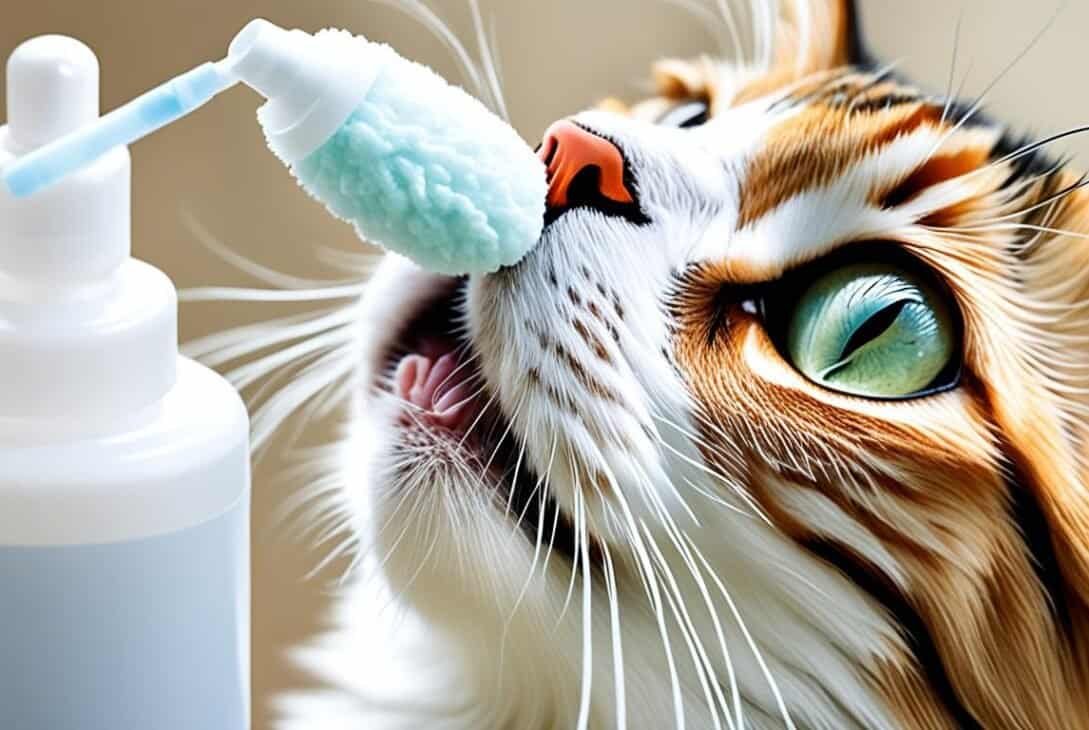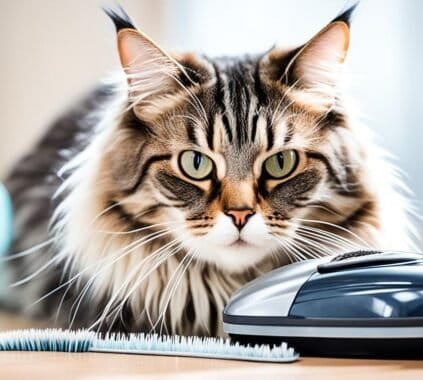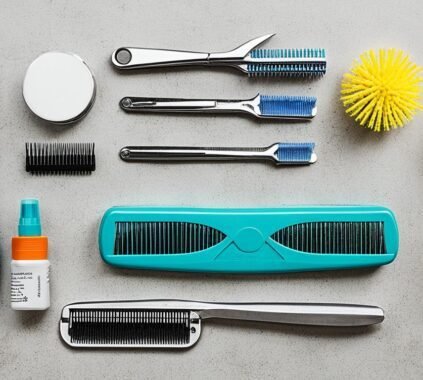Proper cat ear care is crucial for ensuring the overall health and well-being of your feline friend. Regularly checking and cleaning your cat’s ears can help prevent issues like infections and ear mites, which can cause discomfort and lead to more serious problems if left untreated.
When it comes to cat ear health, early detection is key. By regularly inspecting your cat’s ears, you can identify any signs of infection or discomfort and take appropriate action. Keep an eye out for symptoms such as odor, redness, swelling, discharge, and discomfort. If you notice any of these signs, it’s important to consult with your veterinarian for professional diagnosis and treatment.
When cleaning your cat’s ears, always use vet-approved products. Avoid using cotton swabs, as they can push debris deeper into the ear canal and potentially damage the sensitive structures inside. Instead, opt for ear cleaners specifically formulated for cats, like Epi-Otic. Follow the instructions provided by your veterinarian and gently apply the cleaner to the ear canal. After massaging the base of the ear, give your cat a chance to shake their head to remove any excess cleaner. Finally, gently wipe the ear flap and opening of the ear canal using a cotton ball or gauze.
Key Takeaways:
- Regularly check your cat’s ears for signs of infection or discomfort, such as odor, redness, swelling, and discharge.
- Consult with your veterinarian if you notice any abnormal symptoms to ensure proper diagnosis and treatment.
- Use vet-approved ear cleaners specifically formulated for cats, and avoid using cotton swabs.
- Gently apply the cleaner, massage the base of the ear, and allow your cat to shake their head to remove excess cleaner.
- Gently wipe the ear flap and opening of the ear canal using a cotton ball or gauze.
Why Clean Your Cat’s Ears?
If you want to keep your feline friend healthy and happy, it’s important to prioritize their ear care. Cleaning your cat’s ears regularly can help prevent common issues such as ear mites, bacterial infections, and wax buildup. By maintaining proper ear hygiene, you can ensure your cat’s overall ear health and well-being.
Regular ear checks are crucial for spotting any potential problems early on. By inspecting your cat’s ears regularly, you can identify any signs of infection, inflammation, or discomfort. This allows you to seek veterinary care promptly, preventing the issue from worsening and ensuring your cat receives appropriate treatment.
Prevention is always easier and more cost-effective than treatment. By incorporating routine ear cleaning into your cat’s grooming regimen, you can prevent ear mites, infections, and excessive wax buildup. This proactive approach not only saves you from potential vet bills but also keeps your cat’s ears clean and comfortable.
Furthermore, consistent ear cleaning offers numerous benefits for your cat’s ear health. It helps remove dirt, debris, and excess wax, promoting better airflow and preventing blockages. This, in turn, reduces the risk of developing painful ear infections and discomfort for your furry companion.
Remember, a cat’s ears are delicate, and improper cleaning techniques can cause harm. It’s essential to use vet-approved ear cleaners specifically designed for feline use. Additionally, always consult with your veterinarian for personalized advice on how often to clean your cat’s ears and the best products to use.
How to Clean Your Cat’s Ears Safely
Properly cleaning your cat’s ears is essential for their overall ear health. Here’s a step-by-step guide on how to clean your cat’s ears safely.
1. Choose a Vet-Approved Ear Cleaner
It’s important to use a vet-approved ear cleaner, such as Epi-Otic, specifically formulated for cats. These products are designed to effectively clean the ears without causing any harm.
2. Avoid Cotton Swabs
When cleaning your cat’s ears, never use cotton swabs. These can push debris further into the ear canal and potentially damage the delicate eardrum. Stick to using soft and gentle materials like cotton balls or gauze.
3. Apply the Ear Cleaner
Gently hold your cat’s ear flap and apply a few drops of the vet-approved ear cleaner directly into the ear canal. Be careful not to insert the dropper too far into the ear.

4. Massage the Base of the Ear
After applying the ear cleaner, massage the base of your cat’s ear gently. This helps distribute the cleaner and loosens any debris or wax buildup inside the ear canal.
5. Allow Your Cat to Shake Their Head
After massaging, allow your cat to shake their head. This motion helps remove the excess cleaner and dislodges any debris or wax from the ear canal. Be prepared for a little mess!
6. Wipe the Ear Flap and Opening
Using a clean cotton ball or gauze, gently wipe the ear flap and the opening of the ear canal. Be gentle and avoid inserting anything into the ear canal. This step helps remove any remaining debris or cleaner.
7. Repeat for the Other Ear
Follow the same process for the other ear, ensuring both ears are thoroughly cleaned. Each ear should be treated separately to avoid cross-contamination.
8. Reward Your Cat
After the cleaning process, reward your cat with treats and affection for their cooperation. Positive reinforcement helps create a positive association with ear cleaning and makes future cleaning sessions easier.
By following these steps, you can safely clean your cat’s ears and promote their ear health. Remember to consult with your veterinarian for personalized advice on how often to clean your cat’s ears.
Signs to Look Out For
Regularly checking your cat’s ears is crucial for maintaining their ear health. By staying vigilant, you can identify any potential issues early on and take the necessary steps to address them. Here are some signs to look out for:
- Redness: Check for any redness on the outer ear, ear flap, or inside the ear canal.
- Swelling: Look for any swelling or inflammation in and around the ear.
- Discharge: Pay attention to any abnormal discharge, such as pus or excessive wax.
- Discomfort: Observe your cat’s behavior for signs of discomfort, such as frequent scratching or head shaking.
If you notice any of these symptoms, it could indicate a cat ear problem, such as an infection or the presence of ear mites. Promptly consult with your veterinarian for a proper diagnosis and treatment plan tailored to your cat’s needs.
To prevent complications and discomfort for your furry friend, it is essential to address any potential ear problems early. Regular check-ups and feline ear cleaning can help ensure your cat’s ears stay healthy and infection-free.
The Importance of Veterinary Care
Regular veterinary care plays a crucial role in maintaining your cat’s ear health. Visiting a veterinarian allows for thorough ear examinations and ensures that any potential issues are addressed promptly. This proactive approach can help prevent and treat cat ear infections, keeping your feline friend happy and healthy.
Veterinarians possess the expertise and knowledge to identify early signs of cat ear problems and provide appropriate treatment options. Through comprehensive ear examinations, they can determine the cause of any discomfort or infection in your cat’s ears. Whether it’s ear mites, bacterial infections, or other underlying issues, veterinarians can offer effective solutions.
Furthermore, seeking veterinary care allows for personalized advice tailored to your cat’s specific needs. Your veterinarian can guide you on how to prevent cat ear infections through proper cleaning techniques and recommend suitable products. This guidance ensures that you are taking the necessary steps to maintain your cat’s ear health and prevent future ear problems.

Never hesitate to reach out to your veterinarian if you have any concerns about your cat’s ear health. Regular check-ups and open communication with your vet pave the way for optimal cat ear care. By prioritizing veterinary care, you are investing in your cat’s overall well-being and ensuring a happy and comfortable life for your beloved feline companion.
Conclusion
Taking care of your cat’s ears is crucial for their overall health and well-being. By regularly checking and cleaning their ears, you can prevent common issues such as infections and ear mites that can cause discomfort and pain for your feline friend. Prioritizing cat ear care will contribute to their overall happiness and comfort.
Remember to use vet-approved products specifically designed for cat ear care. Consult with your veterinarian to get personalized advice on the best practices and frequency for cleaning your cat’s ears.
With proper cat ear care, you can ensure optimal cat ear health and protect your furry companion from ear-related complications. So make it a routine to regularly check and clean your cat’s ears, and provide them with the necessary care they need for a happy and healthy life.
FAQ
How often should I clean my cat’s ears?
What are the signs of an ear infection in cats?
Can I use cotton swabs to clean my cat’s ears?
How should I clean my cat’s ears?
What should I do if I notice any ear problems in my cat?
How can veterinary care help maintain my cat’s ear health?
Why is it important to have cat ear care?
Last modified: February 25, 2024













